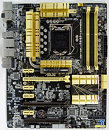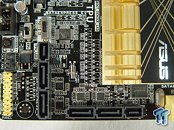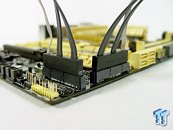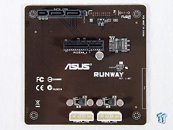Monday, December 23rd 2013

ASUS Z87-Deluxe/SATA-Express Detailed
ASUS released a prototype of the first desktop PC motherboard with SATA-Express support, the Z87-Deluxe/SATA-Express. A variant of ASUS' flagship socket LGA1150 motherboard from its mainline Z87 series, the Z87-Deluxe, the board features two SATA-Express ports. SATA-Express sees a fusion between two of the most successful serial I/O interfaces, SATA and PCI-Express. It's essentially ATA over PCI-Express 2.0 x2, which offers a raw bandwidth of 8 Gbps per direction, 16 Gbps total. The SATA-Express port is structured similar to the classic SATA port, with PCI-Express lanes running over two 7-pin SATA connectors, and an additional block of 4 pins that make up the 18 pins required by 2-lane PCI-Express. A SATA-Express connector is thus unified, and legacy SATA devices should still be able to run off one of the two 7-in SATA connectors in a SATA-Express block.
Since there are no SATA-Express drives in the market, ASUS gave TweakTown a MacGyver contraption that adapts SATA-Express to a physical PCI-Express 2.0 x4 slot (electrical x2). An ASUS RAIDR Express PCI-Express SSD was found to offer sequential transfer rates of around 750 MB/s on ATTO. The rest of the board is practically identical to the Z87-Deluxe. The board uses a 16-phase VRM to condition power for the LGA1150 CPU. It draws power from a combination of 24-pin ATX and 8-pin EPS connectors. Expansion slots include three PCI-Express 3.0 x16 (x16/NC/NC or x8/x8/NC or x8/x4/x4, depending on how they're populated); and four PCI-Express 2.0 x1 slots.The Z87 Express PCH gives out six SATA 6 Gb/s ports, of which two are given away to the two SATA-Express ports (should you decide to plug-in a normal SATA drive into them), while four are given out in ordinary stacks of two ports each. The board offers a total of eight USB 3.0 ports, six on the rear panel, two by headers. Connectivity includes two gigabit Ethernet ports, 802.11 ac Wi-Fi, and Bluetooth 4.0. Display connectivity includes a DisplayPort 1.2 connector, and HDMI 1.4a. 8-channel HD audio with optical (TOSLINK) digital output, and a number of USB 2.0/1.1 ports make for the rest of the connectivity. ASUS didn't reveal availability details. For more benchmark results of the RAIDR Express on this board, click on the source link.
Source:
TweakTown
Since there are no SATA-Express drives in the market, ASUS gave TweakTown a MacGyver contraption that adapts SATA-Express to a physical PCI-Express 2.0 x4 slot (electrical x2). An ASUS RAIDR Express PCI-Express SSD was found to offer sequential transfer rates of around 750 MB/s on ATTO. The rest of the board is practically identical to the Z87-Deluxe. The board uses a 16-phase VRM to condition power for the LGA1150 CPU. It draws power from a combination of 24-pin ATX and 8-pin EPS connectors. Expansion slots include three PCI-Express 3.0 x16 (x16/NC/NC or x8/x8/NC or x8/x4/x4, depending on how they're populated); and four PCI-Express 2.0 x1 slots.The Z87 Express PCH gives out six SATA 6 Gb/s ports, of which two are given away to the two SATA-Express ports (should you decide to plug-in a normal SATA drive into them), while four are given out in ordinary stacks of two ports each. The board offers a total of eight USB 3.0 ports, six on the rear panel, two by headers. Connectivity includes two gigabit Ethernet ports, 802.11 ac Wi-Fi, and Bluetooth 4.0. Display connectivity includes a DisplayPort 1.2 connector, and HDMI 1.4a. 8-channel HD audio with optical (TOSLINK) digital output, and a number of USB 2.0/1.1 ports make for the rest of the connectivity. ASUS didn't reveal availability details. For more benchmark results of the RAIDR Express on this board, click on the source link.




14 Comments on ASUS Z87-Deluxe/SATA-Express Detailed
I bet the guy who made the MacGyver contraption has a fun job.
lol its also my first real build from scratch, before that I use to buy custom prebuild. :)
can we start calling it the S-ex port????